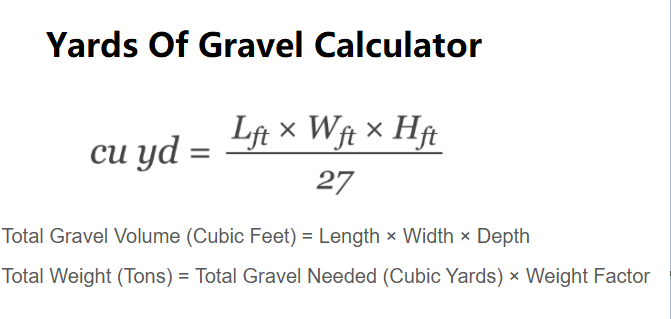Gravel By Yard Calculator - Calculate Yards of Gravel Needed
Calculation Formula
Total Gravel Needed (Cubic Yards) = (Length × Width × Depth) / 27
Total Gravel Volume (Cubic Feet) = Length × Width × Depth
Total Weight (Tons) = Total Gravel Needed (Cubic Yards) × Weight Factor
Gravel Sizes and Weight Factors
| Gravel Size (inches) |
Weight (tons per cubic yard) |
| 2 |
1.40 |
| 1.75 |
1.45 |
| 1.5 |
1.50 |
| 1.25 |
1.55 |
| 1 |
1.60 |
| 3/4 |
1.65 |
| 1/2 |
1.68 |
| 1/4 |
1.70 |
How Many Cubic Yards of Gravel Are Needed?
To determine the cubic yards of gravel needed, input the dimensions of the area (length, width, and depth) in your chosen units. The calculator converts these to feet, calculates the volume in cubic feet, and then divides by 27 to get cubic yards. For example, a 10 ft × 10 ft × 0.5 ft area equals 50 cubic feet, or approximately 1.85 cubic yards.
FAQs
1. What is the purpose of this calculator?
This calculator determines the amount of gravel needed in cubic yards for a given area based on its length, width, and depth, and also provides the volume in cubic feet and weight in tons.
2. How do I choose the right gravel size?
Gravel size depends on your project. Larger sizes (e.g., 2 inches) are better for drainage, while smaller sizes (e.g., 1/4 inch) are ideal for pathways or decorative purposes. The calculator adjusts the weight based on the size selected.
3. Why is depth important in calculating gravel needs?
Depth determines the thickness of the gravel layer. A deeper layer increases the total volume required. For example, a 3-inch depth requires more gravel than a 1-inch depth for the same area.
4. Can I use this calculator for irregular shapes?
This calculator assumes a rectangular area. For irregular shapes, break the area into smaller rectangles, calculate each separately, and sum the results for an estimate.
5. How accurate are the weight estimates?
The weight in tons depends on the gravel size’s weight factor (e.g., 1.40 to 1.70 tons per cubic yard). These are average values; actual weight may vary slightly due to gravel composition and moisture content.

 Home
Home Back
Back